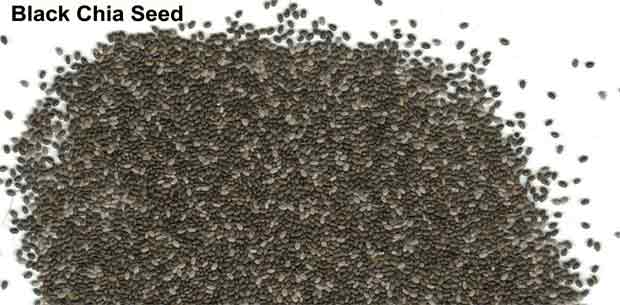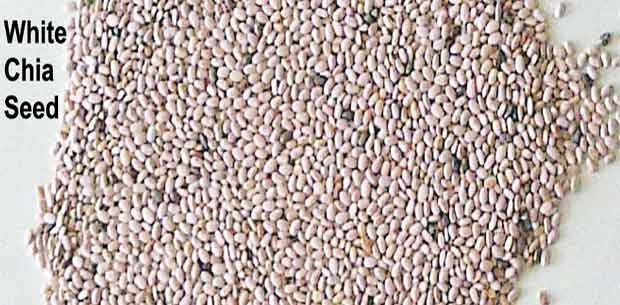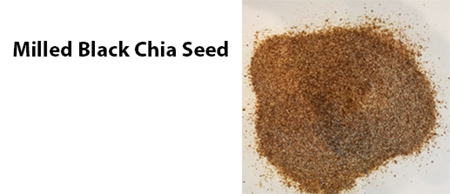Wayne Coates
Professor Emeritus
The University of Arizona
Chia (Salvia hispanica L.) is one of the best, if not the best, functional food in the marketplace today.
What is a functional food?
A functional food can be defined as a food which has one or more health-promoting and/or disease-preventing components. Hence a functional food goes beyond the basic function of supplying nutrients.
There are four types of functional foods:
- Basic Foods – a natural, raw food with nothing added (eg. chia seed)
- Processed Foods with Added Ingredients – (eg. a juice to which calcium has been added)
- Foods With Increased Functional Attributes – brought about by plant breeding, feeding animals special rations, or genetic engineering, (eg, feeding chia to chickens so as to improve egg and/or meat quality)
- Isolated or Purified Preparations – derived from foods (eg. omega-3 fish oils)
Chia falls into two of the four functional food groups. Not only is it a functional food in its raw form, but it can be fed to animals to make healthier products. Given that the FDA has classified chia as a food, and it has no known limitations in terms of consumption. What this means is that it can be freely consumed without concern. This is unlike a number of other functional foods which in their whole or modified forms if overeaten can be harmful or even toxic.
Another advantage chia seed has is that it is essentially flavorless, so it can be added to any other food and will not change its flavor. Additionally the seed does not have to be ground, but if ground will still have a long shelf due to the presence of natural antioxidants. This is unlike flaxseed, for example, which must be ground daily to prevent oxidation, or if bought ground has had some type of stabilizer added, thereby no longer making it a Basic Functional Food.
What are some components of functional foods, and how can these improve your health?
Fiber
Chia contains both insoluble and soluble fiber, with both components varying in amounts depending upon growing location and environmental conditions during the growth cycle. In general total fiber content is approximately 28 to 32 percent, with the insoluble portion ranging from 3.5 to 4.5 percent.
The general health benefits of fiber are:
- Insoluble – reduced risk of breast and colon cancer
- Soluble – reduced risk of cardiovascular disease and some cancers
More specifically the health benefits of consuming fiber are:
- Fiber is important for gastrointestinal health and plays an important role in normal laxation. A larger and softer mass produced by consuming fiber-containing foods causes the large intestine to contract and move the contents towards excretion more rapidly.
- Consumption of foods containing fiber has been associated with a reduced risk of type 2 diabetes. This is thought to occur by the fiber helping to normalize the glucose response and decrease insulin concentration and requirements.
- Meals rich in fiber are processed more slowly by the body, provide more volume compared to lower fiber meals, and tend to produce a feeling of fullness with fewer calories. In addition, high fiber foods require more chewing and take longer to eat, thus potentially limiting total energy intake. All of these characteristics combine to provide a means of weight control.
- Evidence for fiber’s role in reducing the risk of coronary heart disease (CHD) is strong enough that a recommended adequate intake for fiber has been established. Additionally studies have revealed that viscous fibers, like the soluble fiber in chia, are most effective in reducing blood cholesterol levels.
Omega 3 Fatty Acids
Chia contains one of the highest, if not the highest, amount of omega 3 fatty acids known in the plant world. As with fiber the amount of omega 3 fatty acid in the seed varies with planting location and environment during the growing season. In general the amount ranges from 58 to 65% of the total oil content, with the latter value ranging from 30 to 35%.
The omega 3 fatty acid found in chia, which is known as alpha linolenic fatty acid (ALA) is the only essential omega 3 fatty acid. This means a person must consume this fatty acid, since the body cannot manufacture it. This is unlike EPA and DHA (which come from marine sources) which the body manufactures from ALA. There is much discussion about how much ALA is converted to EPA and DHA, with the general consensus being that everyone converts differently, with the amount regulated by what the body needs. The only external factor that affects conversion is over-consumption of omega 6 fatty acids This occurs since the enzymes that convert ALA also convert omega 6 fatty acids. If too many are expended in the omega 6 conversion, less ALA will be converted.
The general benefits of consuming omega 3 fatty acids are reduced risk of cardiovascular disease, improved mental functions.
More specifically the health benefits of consuming omega 3 fatty acids are:
- A decrease in serum triglyceride and total cholesterol levels, with a potential increase or no effect on high-density-lipoprotein (HDL) cholesterol.
- A potential reduction in the symptoms of hypertension, depression, joint pain and other rheumatoid problems.
- A reduction in the symptoms of attention deficit hyperactivity disorder (ADHD),
- Boosting the immune system, and offering protection from an array of illnesses, including Alzheimer’s disease.
- In young children, omega-3 fatty acids also aid in neurological development.
There is also evidence that a shortage of omega3 fatty acids in the diet leads to low leptin levels in the body. Low leptin levels have been shown to signal the brain to deposit fat to increase energy reserves in the body. Thus an adequate intake of omega3 fatty acids may aid in weight management.
Antioxidants and Phytochemicals
These two components have recently been recognized as being important to human health, but are not necessary for life. In some cases these terms have been used interchangeably. Of interest is the fact that Phytochemicals (or sometimes called Phytonutrients) may act as antioxidants, but not all phytochemicals are antioxidants.
Antioxidants are a much more complicated components in terms of their composition, potential benefits, etc. One measure that has been developed to describe overall antioxidant capacity of foods is called Oxygen Radical Absorbance Capacity (ORAC). Chia seed has a relatively high ORAC value, ranging from 60 to 85 μmoles TE/g, with growing location and climate affecting the value. With chia seed there is another important attribute that affects ORAC value, that is seed color. In general darker colored foods have a higher ORAC value than lighter colored foods. This applies to chia seed as well with the black seed having a higher value than the white.
When looking at antioxidants in foods they can be divided into two main groups or categories, with each having similar and as well as different benefits in terms of human health. The two groups and their general benefits are as follows:
- Vitamins and Minerals – protects cells from free radicals which can cause oxidative stress or damage to cells in the body
- Phenols or Phenolic Compounds – reduced risk of cardiovascular heart disease and cancer, protect cells from free radicals
As noted earlier, the classification system used to describe antioxidants in foods is not a simple one, since there are many subcategories under the two main categories. Within the vitamins and minerals group are four major constituents: Vitamins A, C, and E along with Selenium. Chia is not a particularly important source of any of these components, although all are present.
It is the second category, the phenolics, which chia contains significant amounts of. Within this group are several sub-categories, with Phenolics or Polyphenols being divided into tannins and phenylpropanoids. Within the latter group are the flavonoids, which include several thousand compounds, including flavonols, flavones, catechins, flavanones, anthocyanidins, and isoflavonoids. Chia contains a number of these compounds including the flavonoids: Quercetin, Kaempferol, Myricetin; the phenolic acids: Ferulic, Caffeic, p-Coumaric and chlorogenic; along with Catechins; and Phytic acid.
More specifically the health benefits of consuming antioxidants are as follows:
- Oxidative stress arising from the presence of free radicals is associated with a number of degenerative diseases that come with aging including:
- Antioxidants have been shown to reduce oxidative stress, and hence help to prevent onset of these diseases.
• cancer
• cardiovascular disease
• cognitive impairment
• Alzheimer’s disease
• Parkinson’s disease
• immune dysfunction
• cataracts
• macular degeneration
What else about chia makes it a great food?
Protein
Chia is a great source of protein. It contains approximately 20% or more protein. This is more than wheat which is around 14%.
Not only is the amount of protein important, quality of protein is even more important. Protein quality is based on a scoring method that looks at the essential amino acids that make up the protein. This determines whether or not it is a high-quality or a complete protein. Lysine tends to be the most common limiting amino acid, and this is the case with both wheat and chia. The amino acid score for wheat is around 55, whereas for chia it is 91. Thus both the quality and quantity of chia protein is better than that of wheat.
Vitamins and Minerals
As noted earlier chia is not a particularly good source of the vitamins that act as antioxidants, but it does contain a reasonable amount of Niacin and Folic Acid. In terms of minerals it is a good source of Calcium, Magnesium, Iron and Potassium, plus it is relatively low in Sodium.
Other aspects of chia which make it a great and safe food
Chia is cholesterol, trans fat and gluten free. Not only does this mean consumption of chia will not increase a person’s risk of suffering coronary heart disease, but it means it is safe for individuals suffering from celiac disease.
Additionally limited allergen tests have shown no reactions to chia, even in nut sensitive individuals, making this a very safe food for people of all ages.
As a final note the FDA in 2005 confirmed in a letter to Dr. Wayne Coates that chia is a food and is safe to eat. The letter stated in part:
and
“chia has been consumed by native cultures for long periods of time, and we are not aware of any safety concerns”







